Central Vietnamese Cuisine: Rich and Diverse Culinary Delights
Vietnamese food is a global favorite, renowned for its vivid tastes, fresh ingredients, and distinctive culinary traditions. While many people are aware of the classic cuisine of Hanoi and Ho Chi Minh City, Central Vietnam's culinary riches are still relatively unknown. This area, which includes cities such as Vietnam Hue, Da Nang, and Hoi An, provides a unique culinary experience that reflects its rich history and cultural variety. In this article, we will look at the must-try Central Vietnamese cuisine, emphasizing the specific traits that set it apart.
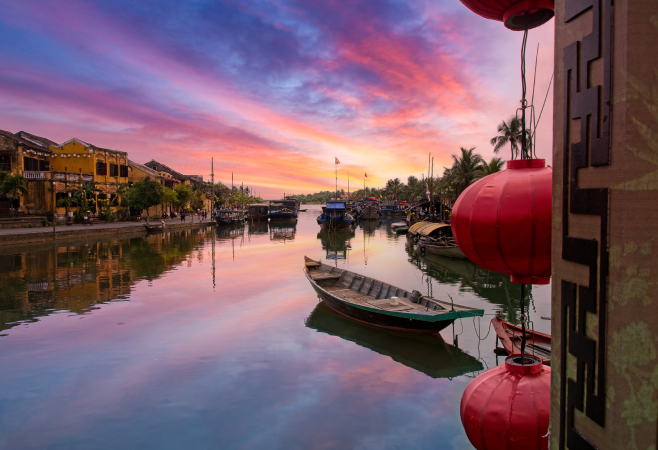
Discover the diversity of Central Vietnamese cuisine for international travelers
The Essence of Central Vietnam Food
Central Vietnam is known for its powerful and spicy tastes, which contrast sharply with the north's gentler, more delicate dishes and the south's sweet, fragrant cuisine. The gastronomy here is heavily influenced by the royal cuisine of Hue, the Nguyen Dynasty's historic capital. This historical influence is reflected in the precise preparation and presentation of foods, which are frequently more intricate and sophisticated.
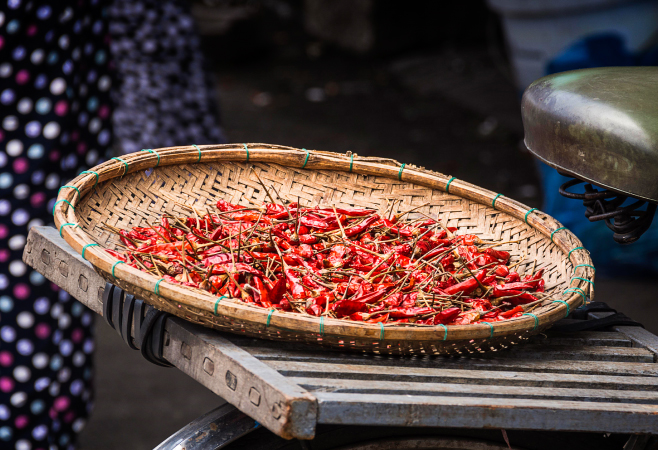
Learn some things about special ingredients of Central food
Key Ingredients and Flavors
- Chili and Spices: Central Vietnamese cuisine is well-known for its liberal use of chili peppers, which results in flavorful dishes. Aromatic herbs such as lemongrass and ginger moderate the heat, resulting in a harmonic taste combination.
- Fermented Shrimp Paste (Mam Ruoc): This spicy ingredient is a mainstay in many Central Vietnamese recipes, offering a distinct depth of flavor. It is commonly used in sauces and marinades.
- Rice and Rice Products: Rice is a staple in much of Vietnam. Rice's adaptability is seen in a variety of forms, including rice noodles and rice paper.
- Fresh herbs and vegetables: Herbs such as coriander, mint, and Thai basil are crucial for adding freshness and balance to spicy and savory recipes.
Taste Must-Try Central Vietnam Cuisine for tourists
1. Bun Bo Hue (Hue Beef Noodle Soup)
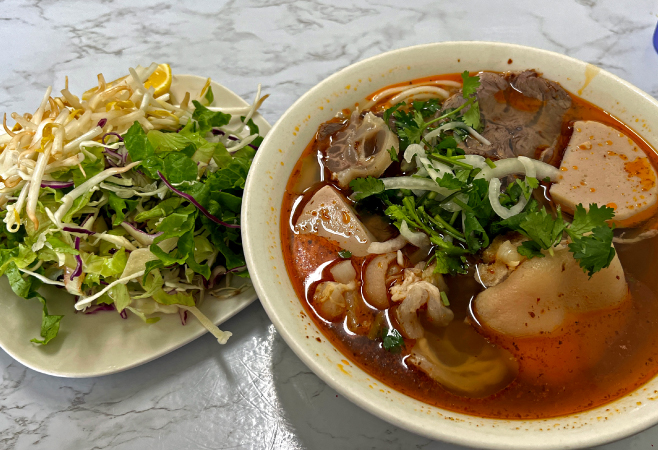
Bun Bo Hue is one of the most popular foods in Central Vietnamese
Bun Bo Hue is a must-try when exploring Central Vietnamese cuisine. This substantial soup comes from Hue and is distinguished by its thick, spicy broth made from cow bones, lemongrass, and fermented shrimp paste. The soup is garnished with thick rice noodles, succulent beef pieces, and a variety of fresh herbs and vegetables.
2. Banh Beo
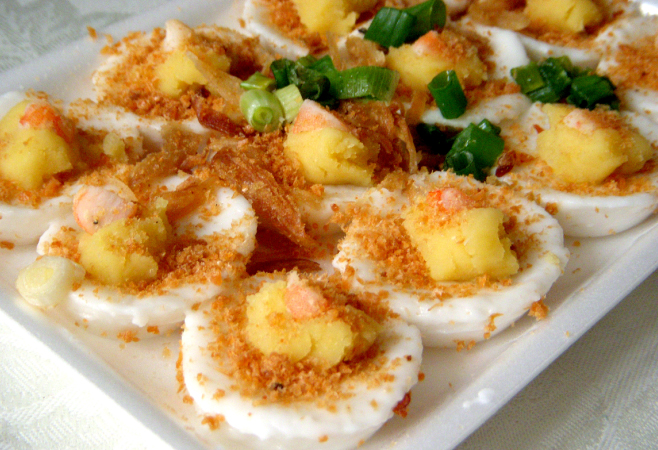
Banh Beo is a traditional food of local Central Vietnamese
Banh Beo are exquisite steamed rice cakes that are traditionally served in tiny, flat platters. These cakes, topped with savory ingredients like minced shrimp, scallions, and crispy fried shallots, are best served with a drizzle of fish sauce. Bánh Bèo, originating in Hue, exemplifies the delicate and savory bites that distinguish Central Vietnamese cuisine.
3. Cao Lau (Hoi An Noodles)
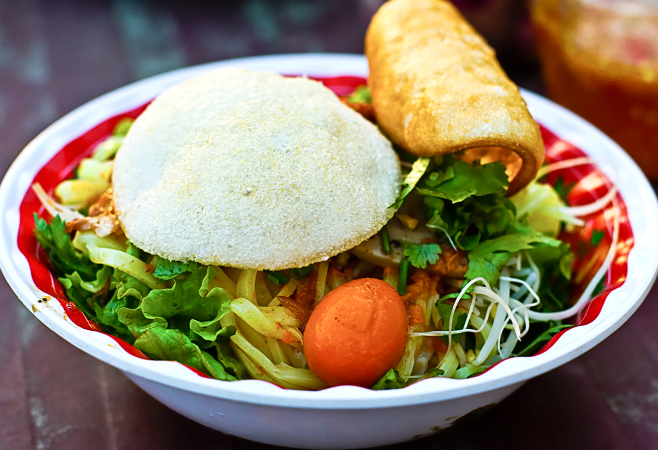
Cao Lau is one of the best dishes that must try in Hoi An
Cao Lau, a popular noodle dish in Hoi An, reflects the region's many cultural influences. The noodles, produced from rice steeped in water and infused with ash from nearby trees, have a distinct feel. They're served with pig pieces, fresh herbs, and crisp croutons in a light, delicious broth. The dish incorporates Chinese, Japanese, and Vietnamese culinary traditions.
4. Mi Quang (Quang Noodles)
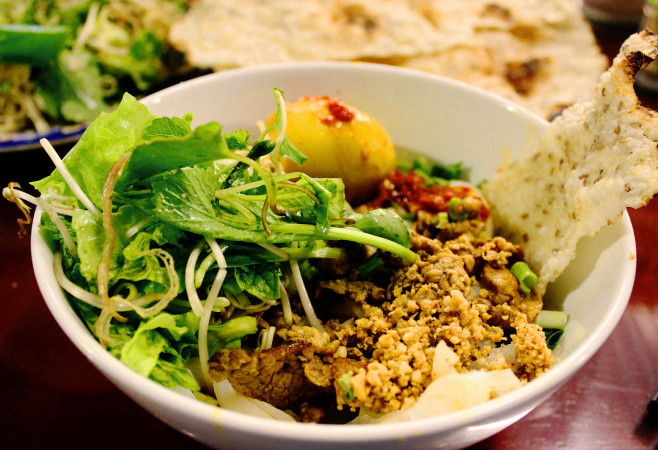
Mi Quang is the most popular cuisine in Central Vietnamese
Mi Quang, a well-known noodle dish from Quang Nam province, has turmeric-infused rice noodles. It is usually served with a variety of meats, such as shrimp, pig, and quail eggs, and topped with peanuts, fresh herbs, and a crispy rice cracker. The meal is finished with a modest amount of rich broth, resulting in a noodle salad rather than a soup.
5. Nem Lui (Grilled Pork Skewers)
Nem Lui is made of minced pork blended with spices, fashioned into lemongrass sticks, then grilled to perfection. These skewers are frequently supplied with rice paper, fresh herbs, and a zesty dipping sauce, allowing customers to make their own fresh spring rolls.
6. Banh Khoai (Crispy Pancakes)
Banh Khoai is a smaller and thicker version of the crispy pancake Banh Xeo from southern Vietnam. These pancakes, filled with shrimp, pork, and bean sprouts, are often served with a special dipping sauce made from fermented soybeans, delivering a distinct and wonderful flavor experience.
Explore Street Food and Market Delights
Central Vietnam is also a heaven for street food enthusiasts. The busy markets and street sellers serve a variety of economical and delightful foods that demonstrate the region's culinary creativity.
1. Banh Mi Hoi An
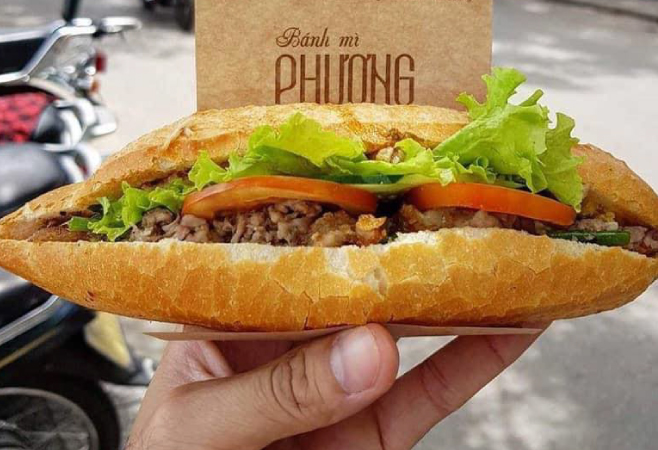
Banh Mi Hoi An is a must-try dish when tourists travel Hoi An
While Banh Mi is popular throughout Vietnam, the Hoi An version is particularly famous. The crispy baguette is filled with a variety of ingredients, including pate, grilled pork, fresh herbs, and pickled vegetables, making for a perfect, flavorful bite.
2. Che Hue (Hue Sweet Soup)
Che Hue is a delicious sweet dessert with many components such as beans, fruits, jellies, and coconut milk. These sweet soups are popular as a refreshing dessert or snack, particularly in Central Vietnam's warm environment.
Dining Etiquette and Tips
When eating Central Vietnamese cuisine, it's essential to be aware of several local dining customs:
- Sharing is Caring: Vietnamese dinners are frequently served family style, with many dishes shared across the table. This allows everyone to enjoy a wide range of flavors and sensations.
- Use of Chopsticks: Chopsticks are the primary tools, but if you're not comfortable with them, ask for a fork and spoon.
- Respect the cuisine: Vietnamese people hold a high regard for their cuisine, which is evident in its presentation and consumption. Take the time to enjoy the flavors and artistry that go into each dish.
- Fish Sauce: Nuoc Mam (fish sauce) is a common condiment. It is commonly combined with lime, sugar, and chile to make a dipping sauce. Don't be afraid to ask for it if it's not already on the table.
Conclusion
Central Vietnamese cuisine is a celebration of the region's rich cultural legacy and natural richness. From the royal cuisine of Hue to the street food of Hoi An, each taste takes you on a trip through history and culture. Whether you're a culinary explorer or a comfort food lover, Central Vietnam's cuisine will excite your taste buds and leave you wanting more. As you explore this rich gastronomic environment, remember to relish each moment and admire the creativity that makes Central Vietnamese cuisine so unique.
Applying for travel documents to experience Central Vietnam's diverse culinary environment would lead to an unforgettable gourmet trip. Central Vietnam, known for its robust and spicy tastes, serves a wide variety of foods that represent the country's rich history and cultural influences. From Hue's regal cuisine to Hoi An's lively street food, each meal is a sensory feast. Make sure your passport is up to date, then verify the visa requirements for Vietnam. Once your travel document is in order, you may enjoy the region's distinct gastronomic culture, including delicacies like Bun Bo Hue, Banh Beo, and Cao Lau. The exquisite tastes and gastronomic experiences that will repay your efforts in obtaining your travel documents
Related Articles
- Vietnamese Culture and Traditions: A Deep Dive Discovery
- Experience The Magic Of Vietnam Lunar New Year (Tet Holiday)
- Christmas Day In Vietnam - Discovering Joyful Festival of Christmas in Asia
- Sapa Travel Guide To Explore the Beauty of Northern Vietnam
- Exploring The Tapestry Of Vietnamese Cuisine
- Mekong Delta Tour Guide: Exploring the Waterways of Vietnam
- Vietnamese Architecture Style - Evolution Through The Ages
- A Guide To The Autumn Festival In Vietnam For Tourists
HOW CAN WE HELP?
APPLY WITH CONFIDENCE










